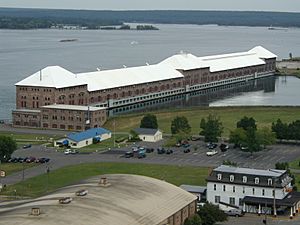Saint Marys Falls Hydropower Plant facts for kids
Quick facts for kids Saint Marys Falls Hydropower Plant |
|
|---|---|

The Saint Marys Falls Hydropower Plant (1902), a Historic Civil Engineering Landmark.
|
|
| Country | United States |
| Location | Sault Ste. Marie, Michigan |
| Coordinates | 46°29′51″N 84°19′56″W / 46.49743°N 84.33213°W |
| Power station | |
| Type | Run-of-the-river |
| Installed capacity | 18 MW |
The Saint Marys Falls Hydropower Plant is a big power station in Sault Ste. Marie, Michigan. People often call this place "the Soo." This plant uses the power of water from the St. Marys River to make electricity. It can produce 18 megawatts (MW) of power. The Army Corps of Engineers helps manage the water flow. The electricity made here is sent out by the Cloverland Electric Cooperative. This company provides power to homes and businesses in the Soo area.
History of the Power Plant
As of 2021, the Soo hydropower plant is one of the oldest power stations still working in the United States. Building the power canal and the plant started in September 1898. It was finished in June 1902. The plant used early ideas for making large amounts of electricity. This is how the plant and the power company got their old name, Edison Sault. However, Thomas Edison himself did not build this plant.
The Soo hydropower plant was designed to hold 74 generators. All of these generators were placed under one very long roof. The building was made in a style called Classical style. It is an industrial building that is 1,340 feet (about 408 meters) long. It runs next to the St. Marys River. The outside of the building is covered with masonry, which means it's built with stone or brick.
The stone used for the plant's outside walls is called sandstone. These large blocks of stone were taken from the Edison Sault Power Canal. This canal brings water to the power plant. In 1911, President William Howard Taft visited the plant. In 1983, both the power canal and the hydroelectric plant were named a Historic Civil Engineering Landmark. This means they are important examples of engineering history.
Even though the plant could make up to 25-30 megawatts of power, it is usually rated at 18 MW. This is how much power it is expected to produce for the electricity grid.
- Historic American Engineering Record (HAER) No. MI-1, "Michigan Lake Superior Power Company, Portage Street, Sault Ste. Marie, Chippewa County, MI", 141 photos, 2 color transparencies, 8 measured drawings, 237 data pages, 20 photo caption pages


